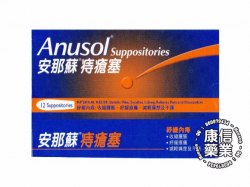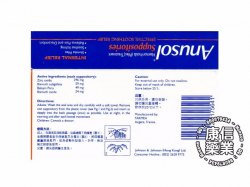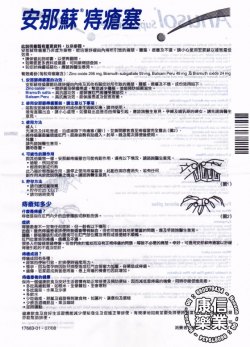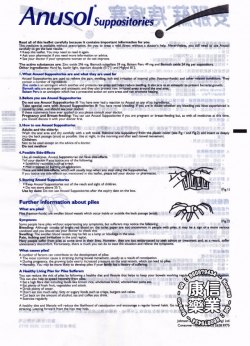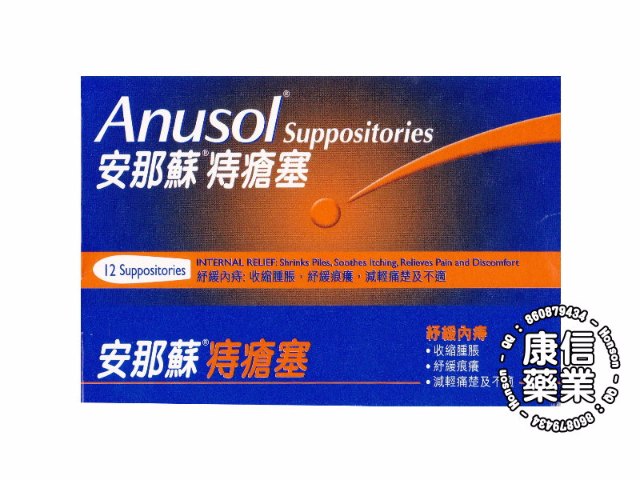
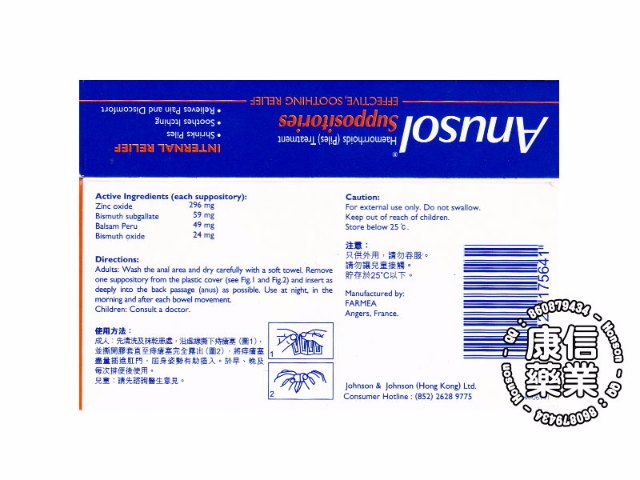
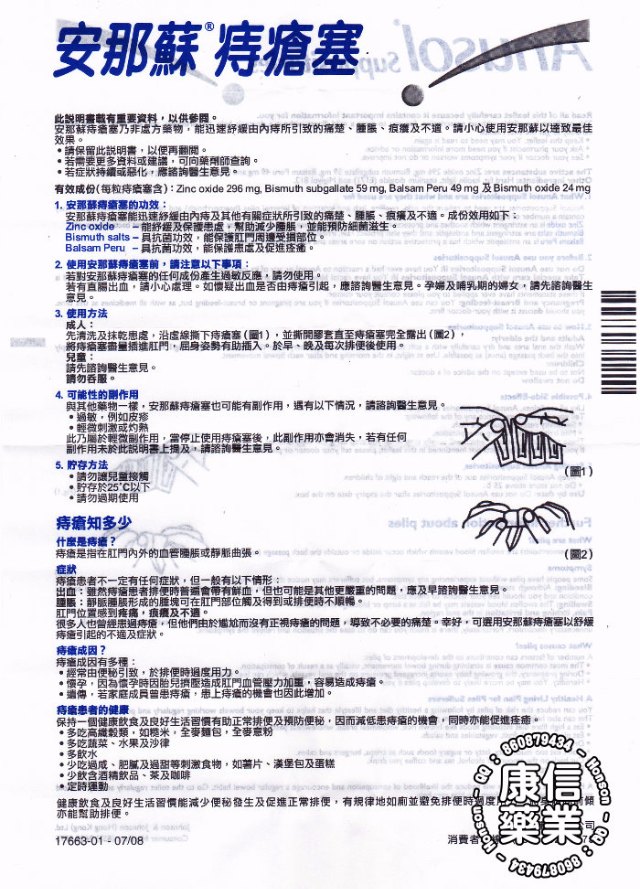
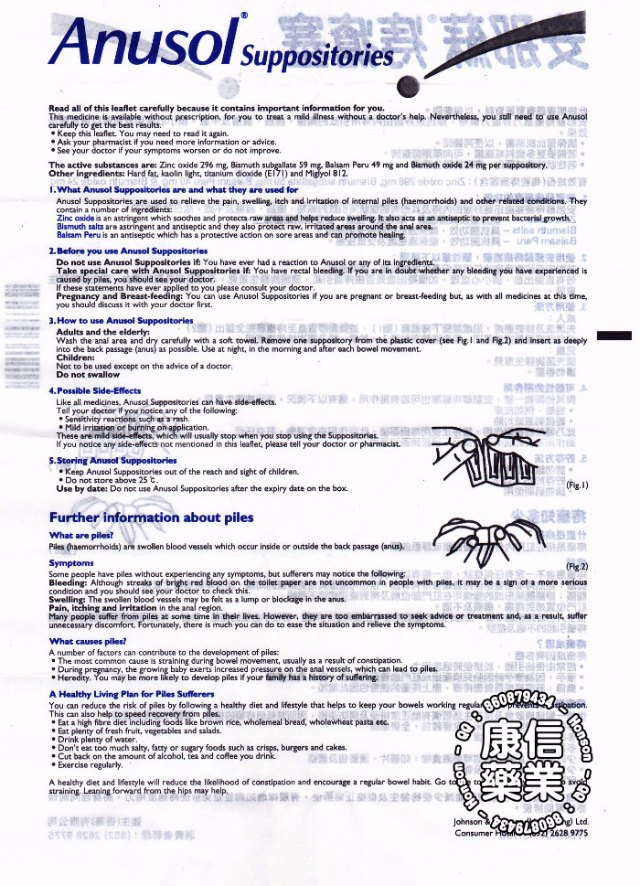
Anusol Ointment
Model: T1201
Product Description
Anusol Haemorrhoid plug
Read all of this leaflet carefully because it contains important information for you.
This medicine is available without prescription, for you to treat a mild illness without a doctor’s help. Nevertheless, you still need to use Anusol carefully to get the best results.
♦ Keep this leaflet. You may need to read it again.
♦ Ask your pharmacist if you need more information or advice.
♦ See your doctor if your symptoms worsen or do not improve.
The active substances are: Zinc oxide 10.75 g,Bismuth subgallate 2.25 g,Balsam Peru 1.875 g and Bismuth oxide 0.875 g per 100 g.
Other ingredients: Magnesium stearate, cocoa butter, lanolin anhydrous, castor oil, kaolin light and petroleum jelly white.
1. What Anusol Ointment is and what it is used for
Anusol Ointment is used to relieve the pain, swelling, itch and irritation of internal and external piles (haemorrhoids) and other related conditions, such as anal itching. It contains a number of ingredients:
Zinc oxide is an astringent which soothes and protects raw areas and helps reduce swelling. It also acts as an antiseptic to prevent bacterial growth.
Bismuth salts are astringent and antiseptic and also protect raw, irritated areas around the anal area.
Balsam Peru is an antiseptic which has a protective action on sore areas and can promote healing.
2. Before you use Anusol Ointment
Do not use Anusol Ointment 论 You have ever had a reaction to Anusol or any of its ingredients.
Take special care with Anusol Ointment if: You have rectal bleeding. If you are in doubt whether any bleeding you have experienced is caused by piles, you should see your doctor.
If these statements have ever applied to you please consult your doctor.
Pregnancy and Breast-feeding: You can use Anusol Ointment if you are pregnant or breast-feeding but, as with all medicines at this time, you should discuss it with your doctor first.
3. How to use Anusol Ointment Adults and the elderly:
Wash the anal area and dry carefully with a soft towel. Apply Anusol Ointment to the affected area at night; in the morning and after each bowel movement Anusol Ointment should be applied on a gauze dressing. For internal piles, screw the noz^e provided on to the cube and remove the nozzle cap. Insert the nozzle into the back passage and squeeze gently. Clean the nozzle after each use. Please wash your hands after use.
Children:
Not to be used except on the advice of a doctor.
4. Possible Side-Effects
Like all medicines, Anusol Ointment can have side-effects.
Tell your doctor if you notice any of the following:
l Sensitivity reactions such as a rash.
l Mild irritation or burning on application.
These are mild side effects, which will usually stop when you stop using the Ointment.
If you notice any side-effects not mentioned in this leaflet please tell your doctor or pharmacist.
5. Storing Anusol Ointment
l Keep Anusol Ointment out of the reach and sight of children.
l Do not store above 251.
Use by date: Do not use Anusol Ointment after the expiry date on the box.
Further information about piles
What are piles?
Piles (haemorrhoids) are swollen blood vessels which occur inside or outside the back passage (anus).
Symptoms
Some people have piles without experiencing any symptoms, but sufferers may notice the following:
Bleeding: Although streaks of bright red blood on the toilet paper are not uncommon in people with piles, condition and you should see your doctor to check this.
Swelling: The swollen blood vessels may be felt as a lump or blockage in the anus.
Pain, itching and irritation in the anal region.
Many people suffer from piles at some time in their lives. However, they are too embarrassed to seek advice unnecessary discomfort Fortunately, there is much you can do to ease the situation and relieve the symptoms.
What causes piles?
A number of factors can contribute to the development of piles:
l The most common cause is straining during bowel movement, usually as a result of constipation.
l During pregnancy, the growing baby exerts increased pressure on the anal vessels, which can lead to piles.
l Heredity. You may be more likely to develop piles if your femily has a history of suffering.
A Healthy Living Plan for Piles Sufferers You can reduce the risk of piles by following a healthy diet and lifestyle that helps to keep your bowels working regularly and prevents constipation. This can also help to speed recovery from piles.
Eat a high fibre diet including foods like brown rice, wholemeal bread, wholewheat pasta etc.
l Eat plenty of fresh fruit, vegetables and salads.
l Drink plenty of water.
l Don't eat too much salty, fatty or sugary foods such as crisps, burgers and cakes.
l Cut back on the amount of alcohol, tea and coffee you drink.
l Exercise regularly.
A healthy diet and lifestyle will reduce the likelihood of constipation and encourage a regular bowel habit. Go to the toilet regularly and try to avoid straining. Leaning forward from the hips may help.

